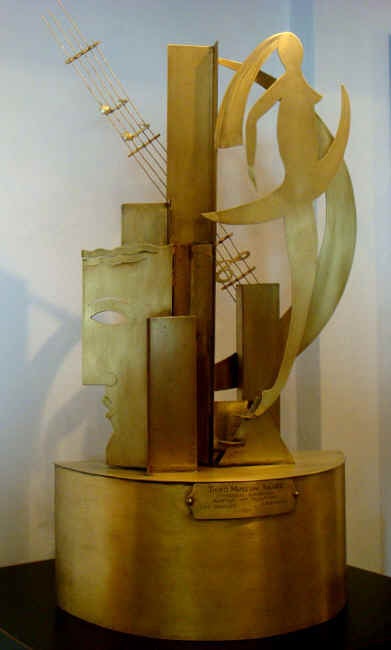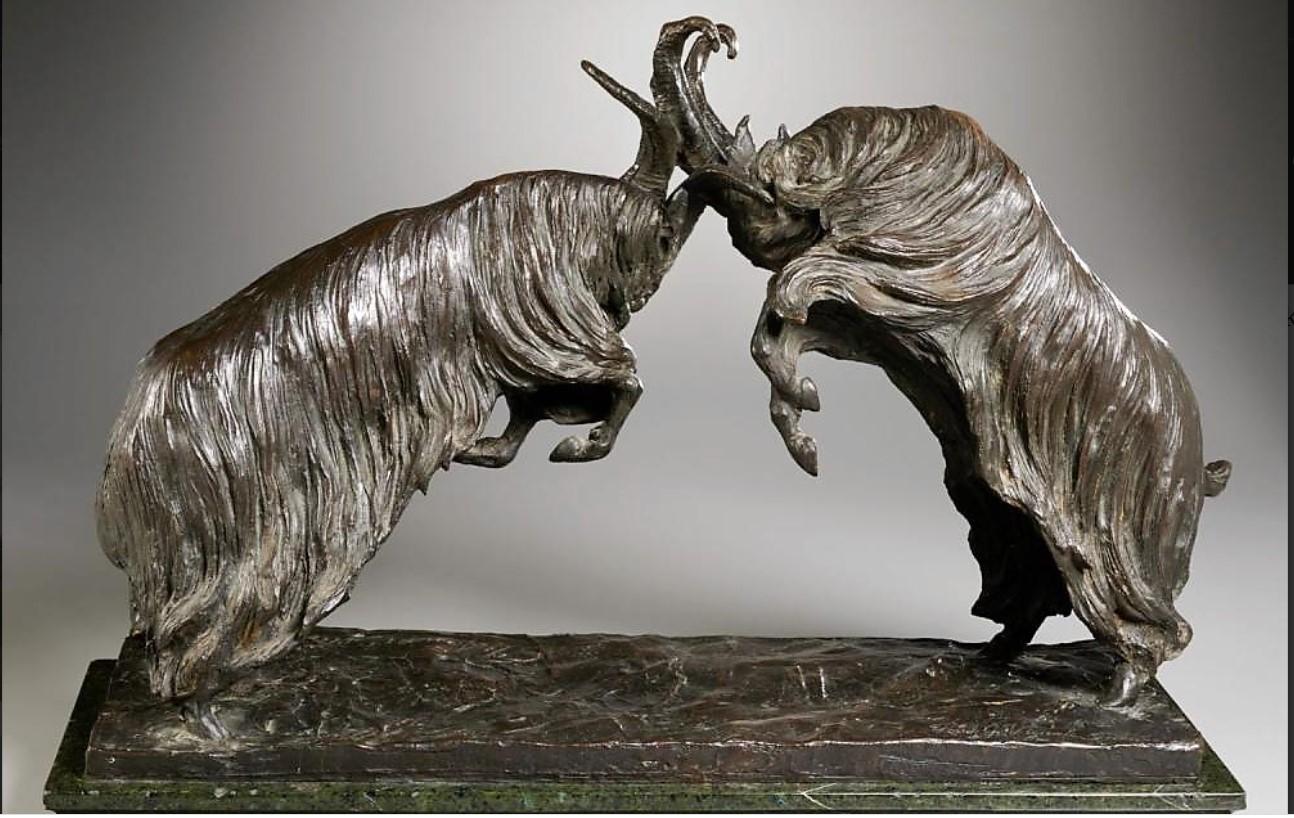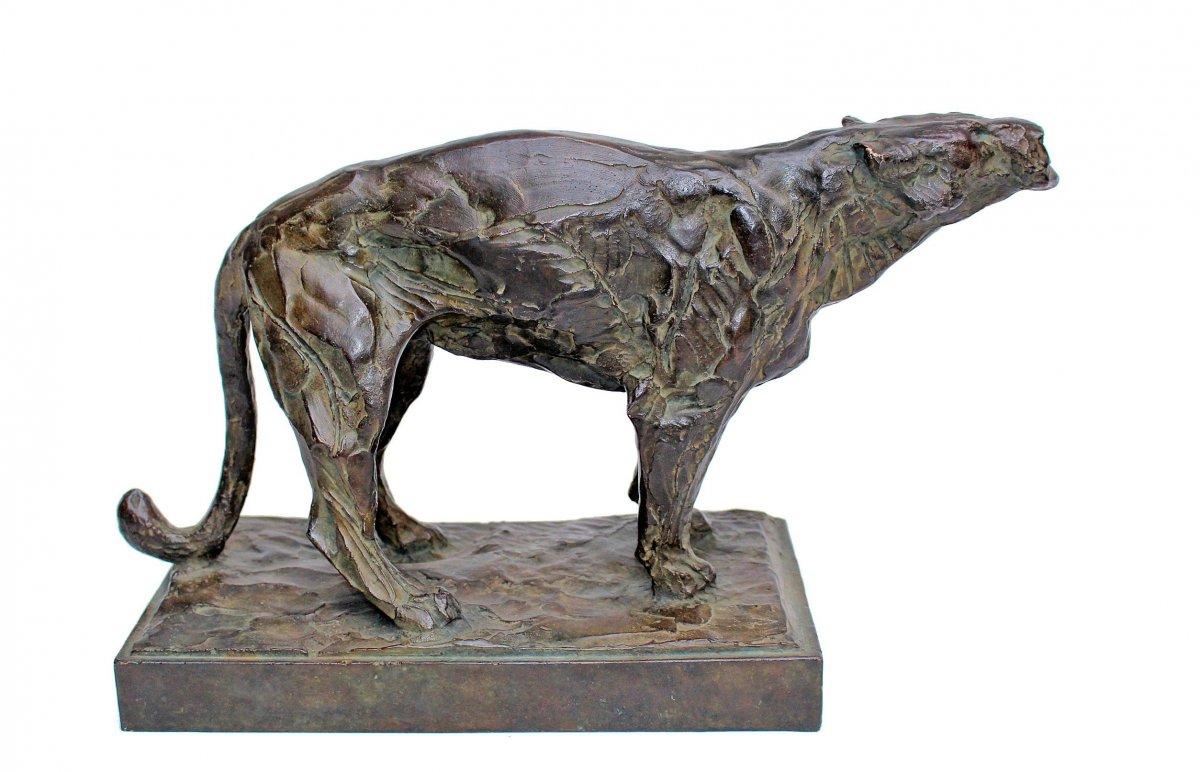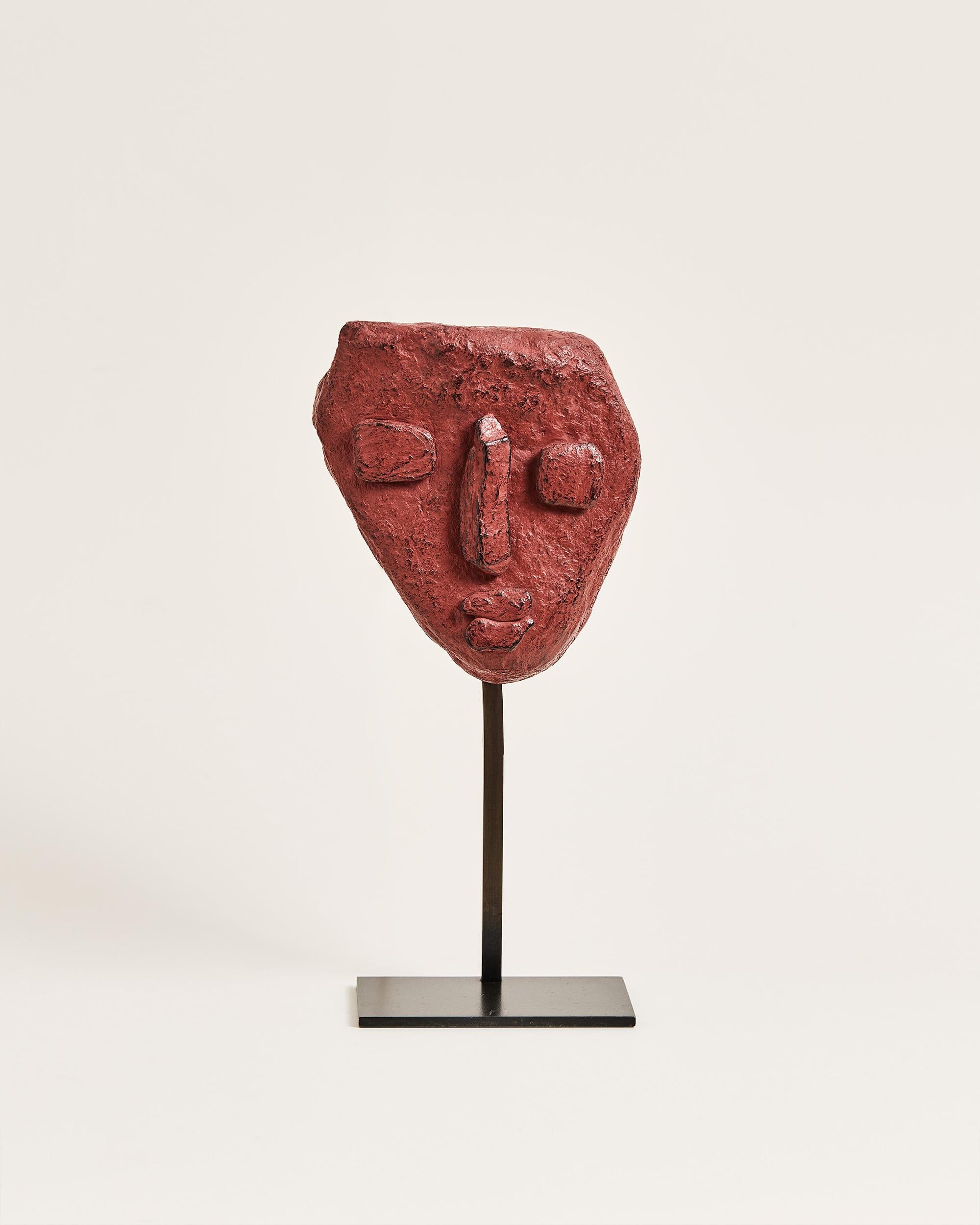Items Similar to Music (attributed)
Want more images or videos?
Request additional images or videos from the seller
1 of 2
Philip Kran PavalMusic (attributed)c. 1936
c. 1936
About the Item
This sculpture is part of our exhibition America Coast to Coast: Artists of the 1930s
Music (attributed), brass and wire construction, c. 1936, 28 x 14 x 5 inches; perhaps exhibited at Hollywood Riviera Gallery, 1936 (third prize); provenance includes Estate of Jon Spencer Helfen (Los Angeles, CA
About the Sculpture
In 1935, Philip Paval bought a box of metal in a “blind auction.” Paval, a painter, sculptor, and jeweler, had hoped the box contained silver. To his dismay, it was brass. Seeing an opportunity, Paval started to make sculptures from the brass sheets. His subjects included Cinema, Hollywood, Radio, Dance, Aviation and Music. The works were well-received with the Hollywood crowd and critically acclaimed. Actor and comedian, Ben Bard, purchased four of them for his theater, and novelist and screenwriter, Vicki Baum ordered four more for her drawing room. Movie director King Vidor also purchased them. Los Angeles Times art critic, Arthur Millier, described Paval’s “contraptions” as “ingenious, decorative, different.” Paval exhibited these works for several years in the late 1930s, including at the American Artists’ Congress Gallery in Los Angeles in an exhibition called Formalism and Abstraction in 1938 and at a solo show at Stendahl Galleries in 1939. The appeal of these works must have been irresistible, as a 1936 Los Angeles Times article noted, “Two feet of brass art has been stolen from the Hollywood Riviera Galleries. The work is an abstraction. It portrays the spirit of music and rested on the grand piano in the main hall. The work of Philip Paval, it won third prize in the current gallery exhibition at the gallery.” One can only wonder whether this is the “contraption” which was pilfered from the gallery nearly one hundred years ago. Given the description of the work, its subject matter and size, it seems likely.
About the Artist
Philip Paval was a sculptor, painter, and jeweler. Born in Denmark, Paval was apprenticed to a silversmith and studied art in Denmark. He immigrated to the US in 1919 and first worked as a merchant seaman in New York. The following year, Paval settled in Los Angeles where he later opened his own jewelry shop featuring works he designed and produced. Paval became a favorite in the entertainment world, making a good living selling silver, gold, and brass sculptures, as well as painting portraits for Hollywood celebrities. He exhibited widely, winning prizes at the Los Angeles County Museum of Art, the Hollywood Riviera Gallery, the Ebell Club, and the California Art Club, where he served as president in the 1950s. In 1968, he wrote an autobiography recounting his experiences, including in Hollywood’s golden age. He is listed in Who was Who in American Art and other standard references.
- Creator:Philip Kran Paval (1899-1971, American)
- Creation Year:c. 1936
- Dimensions:Height: 28 in (71.12 cm)Width: 14 in (35.56 cm)Depth: 5 in (12.7 cm)
- Medium:
- Movement & Style:
- Period:
- Condition:
- Gallery Location:Los Angeles, CA
- Reference Number:1stDibs: LU1859213056542
About the Seller
No Reviews Yet
Vetted Seller
These experienced sellers undergo a comprehensive evaluation by our team of in-house experts.
1stDibs seller since 2022
6 sales on 1stDibs
Typical response time: 6 hours
- ShippingRetrieving quote...Ships From: Los Angeles, CA
- Return PolicyA return for this item may be initiated within 3 days of delivery.
More From This SellerView All
- Winged Male Figure - ApolloLocated in Los Angeles, CAThis work is part of our exhibition America Coast to Coast: Artists of the 1930s Winged Male Figure - Apollo, c. 1930s, polychrome bas-relief of cast aggregate, 12 x 26 inches; the...Category
1930s Art Deco Figurative Sculptures
MaterialsConcrete
- KossackLocated in Los Angeles, CAThis sculpture is part of our exhibition America Coast to Coast: Artists of the 1930s Kossack, c. late 1930s, polychromed cedar and walnut relief sculpture, carved signature under the base of the figure, 15 x 8 x 3 1/2 inches (figure), 10 x 19 inches (board), exhibited at Zeidler's solo exhibition at the San Francisco Museum of Art, November - December, 1942 (label verso), label verso reads "Kossack / cedar & walnut / Avis Zeidler" About the Sculpture Kossack is typical of Aviz Zeidler’s direct carved wood sculptures of the 1930s. The subject looks directly at the viewer, unfeeling behind a polychromed stare. Seemingly influenced by two of her major teachers, California’s Ralph Stackpole and New York’s William Zorach, Zeidler drew on primitive traditions to create what one critic described as her “gruesome wood sculptures.” Rigid, solid, and unmoving are other words that characterize Zeidler’s statues which often seem to have the deeply rooted ancient power of a totem. Zeidler’s “grimacing artificiality does, indeed, manage to hold a sense of force,” is how The San Francisco Examiner art critic put it in 1938 when describing the artist’s award-winning entry at the San Francisco Art Museum. The same words could have applied to Kossack when it was exhibited at the museum four years later. Perhaps the artist was trying to contain the power of the fearsome Kossacks, the enemy of so many Eastern European peasants, by freezing the image in wood. About the Artist Avis Zeidler (Nemkoff) was a California-based artist who is principally known for her sculpture and drawings. She was born in Madison, Wisconsin, but moved to Northern California by the late 1920s where she majored in art at Berkely and studied with Lucien Labaudt, Ray Boynton...Category
1940s American Modern Figurative Sculptures
MaterialsWood
- Two FiguresBy Robert Chester ThomasLocated in Los Angeles, CAThis sculpture is part of our exhibition America Coast to Coast: Artists of the 1940s. Two Figures, 1949, ebony wood, 24 x 7 x 5 inches, unsigned, but comes from Thomas' daughters ...Category
1940s American Modern Sculptures
MaterialsEbony, Wood
- Untitled (Hulda Goeller)Located in Los Angeles, CAThis sculpture is part of our exhibition Charles Goeller: A Wistful Loneliness. Carved and painted wood and gesso, 23 x 15 3/4 x 3 inches, Signed verso "Carved by Charles L. Goeller...Category
1930s American Modern Figurative Sculptures
MaterialsWood, Gesso
- Six O'ClockLocated in Los Angeles, CASix O-Clock, c. 1942, oil on canvas, 30 x 20 inches, signed and titled several times verso of frame and stretcher (perhaps by another hand), marked “Rehn” several times on frame (for the Frank K. M. Rehn Galleries in New York City, who represented Craig at the time); Exhibited: 1) 18th Biennial Exhibition of Contemporary American Oil Paintings from March 21 to May 2, 1943 at The Corcoran Gallery of Art in Washington, D.C. #87, original price $450 (per catalog) (exhibition label verso), 2) Craig’s one-man show at the Frank K. M. Rehn Galleries, New York City, from October 26 to November 14, 1942, #10 (original price listed as $350); and 3) Exhibition of thirty paintings sponsored by the Harrisburg Art Association at the State Museum of Pennsylvania in Harrisburg in March, 1944 (concerning this exhibit, Penelope Redd of The Evening News (Harrisburg, Pennsylvania) wrote: “Other paintings that have overtones of superrealism inherent in the subjects include Tom Craig’s California nocturne, ‘Six O’Clock,’ two figures moving through the twilight . . . .” March 6, 1944, p. 13); another label verso from The Museum of Art of Toledo (Ohio): original frame: Provenance includes George Stern Gallery, Los Angeles, CA About the Painting Long before Chris Burden’s iconic installation outside of the Los Angeles County Museum of Art, Urban Light, another artist, Tom Craig, made Southern California streetlights the subject of one of his early 1940s paintings. Consisting of dozens of recycled streetlights from the 1920s and 1930s forming a classical colonnade at the museum’s entrance, Burden’s Urban Light has become a symbol of Los Angeles. For Burden, the streetlights represent what constitutes an advanced society, something “safe after dark and beautiful to behold.” It seems that Craig is playing on the same theme in Six O-Clock. Although we see two hunched figures trudging along the sidewalk at the end of a long day, the real stars of this painting are the streetlights which brighten the twilight and silhouette another iconic symbol of Los Angeles, the palm trees in the distance. Mountains in the background and the distant view of a suburban neighborhood join the streetlights and palm trees as classic subject matter for a California Scene painting, but Craig gives us a twist by depicting the scene not as a sun-drenched natural expanse. Rather, Craig uses thin layers of oil paint, mimicking the watercolor technique for which he is most famous, to show us the twinkling beauty of manmade light and the safety it affords. Although Southern California is a land of natural wonders, the interventions of humanity are already everywhere in Los Angeles and as one critic noted, the resulting painting has an air of “superrealism.” About the Artist Thomas Theodore Craig was a well-known fixture in the Southern California art scene. He was born in Upland California. Craig graduated with a degree in botany from Pomona College and studied painting at Pamona and the Chouinard Art School with Stanton MacDonald-Wright and Barse Miller among others. He became close friends with fellow artist Milford Zornes...Category
1940s American Modern Landscape Paintings
MaterialsCanvas, Oil
- Abandoned WharfLocated in Los Angeles, CAThis drawing is part of our exhibition Charles Goeller: A Wistful Loneliness. Crayon on paper, 20 x 12 (image), 22 x 14 inches (sheet), Signed lower right, Matted, but not framed Ex...Category
1940s American Modern Landscape Drawings and Watercolors
MaterialsPaper, Crayon
You May Also Like
- Chase Walter Von Nessen Horse Bookends StatueLocated in Oakland, CAExtremely rare set of chase Equestrian bookends sculpture designed by Walter Von Nessen in 1932. Industrial Design incorporated with the latest materials and machine age approach. Th...Category
1930s Art Deco More Art
MaterialsBrass
- HollywoodBy Philip PavalLocated in West Hollywood, CAPhilip Paval was a sculptor and silversmith who worked primarily in Los Angeles. He was known as a Hollywood Artist, as he affiliated with many of the Hol...Category
1930s Art Deco Figurative Sculptures
MaterialsBrass
- Italian Animal Bronze : Battling Rams by Sirio TofanariLocated in Gent, VOVA very rare bronze cast of two battling Rams, by Sirio Tofanari (1886-1969). An old cast with a dark brown shaded patina. On a heavy green marble steppe...Category
1930s Art Deco Figurative Sculptures
MaterialsMarble, Bronze
- Roaring LionnessLocated in Gent, VOVA fine quality, twentieth-century bronze model of a roaring lioness by Alberic Collin (Belgian 1886-1962). Prior to casting by the Valsuani foundry it w...Category
1930s Art Deco Figurative Sculptures
MaterialsBronze
- On PointLocated in WOOLLAHRA, AUArtist Statement “Bronze figurative sculpture has a long tradition. For me, the Art Deco period was the foundation for inspiration. Running parallel to that are ideas that spring fro...Category
2010s Art Deco Figurative Sculptures
MaterialsBronze
- Bronze Eve - Contemporary Bronze Portrait sculpture, 2015Located in PARIS, FRSculpture en bronze sur socle par l'artiste Pascale Hamelin. Pascale Hamelin est une sculptrice française. Ses visages et ses formes racontent le souv...Category
21st Century and Contemporary Art Deco Abstract Sculptures
MaterialsBronze





